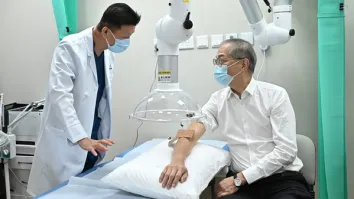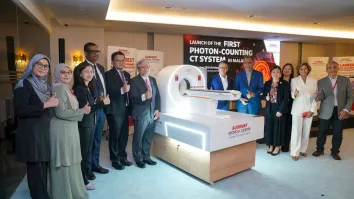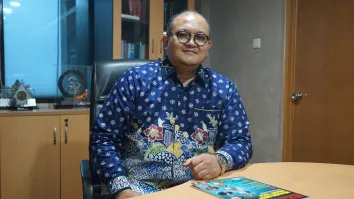
HIMSS provides guidance for digital healthcare in Asia-Pacific
The global non-profit devises ‘maturity models’ to measure and advance healthcare technology on a global scale.
Stepping out of the COVID-19 pandemic, the healthcare industry finds itself wrapped in a world of healthcare technology tools and innovations. Through these advancements, the non-profit global organisation, Healthcare Information and Management Systems Society (HIMSS), is on a mission to measure the technological progress of healthcare providers for the general welfare of the industry.
It’s not enough to be fascinated by rapid technological progress that now allows remote services for patients or faster, more accurate and comprehensive digital testing devices. What HIMSS brings to the table are “maturity models,” which serve as detailed measurement tools in order to harness the power of technology for the continuous improvement of healthcare on a global scale.
“We created maturity models that examine various aspects of digital healthcare technology, from electronic health records to digital imaging to analytics maturity to infrastructure,” Simon Lin, managing director for Asia-Pacific & vice president of HIMSS, told Healthcare Asia in an interview on the sidelines of the recent HIMSS23 APAC event in Jakarta.
These evidence-based maturity models are built using the organization’s extensive work with healthcare providers around the world, and are used as reference points for models used in each country to be continually updated and remain relevant as technology advances. For instance, HIMSS works directly with hospitals in the Asia-Pacific region to support their digital transformation.
HIMSS brings together healthcare professionals, technology experts, vendors, and government institutions to promote and advance digital healthcare technology, said Lin. What makes HIMSS special is its dedication to realising the full potential of human health, no matter where you are in the world.
“We’ve worked with governments at the national level to assess their digital maturity and identify gaps so they can continue to invest effectively. In developing countries like Indonesia and Malaysia, the focus is on supporting them in realising the value of digital health: how to use electronic medical records (EMRs) effectively and how to plan and execute investments,” he said.
Globally, HIMSS collaborates with over 68,000 healthcare organisations and has assisted in improving healthcare for up to 800 million patients.
3 groups in APAC
HIMSS has categorised Asia-Pacific countries based on their levels of digital maturity. Doing so allows the organisations to help countries and their healthcare institutions stay abreast of technology trends with their level of digital maturity in mind, explained Lin.
At the basic level are countries with foundational levels of technology adoption and maturity — where adoption refers to the ownership of technology; and maturity refers to the level of usage.
Lin noted that having technology is different from using technology effectively to achieve goals. “For example, people might think that electronic medical records simply means scanning paper records and uploading them to computers, but it is critical to digitalize all medical records so that the data can be used for analysis and optimizing outcomes,” he said.
The second group comprises countries in the Asia-Pacific region that have made some investments and achieved a certain level of maturity, but lack sufficient resources to progress further. Many countries fall into this second group, with adequate investment and maturity levels, but significant gaps remain for further development.
“We can see that [these ‘middle-tier’ countries] are now in the phase of enhancing their infrastructure and technology. They are modernising EMRs and transitioning from old technology,” said Lin.
The third group consists of countries with highly mature digital healthcare systems. These countries typically have a highly developed digital healthcare system, strong government support and investment, and a reliable workforce to support the transformation and adoption of technology in its healthcare sector.
Lin said that the rapid adoption and maturity of technology in the healthcare field is not surprising.
“From 2000 to 2020, we were in the era of digital healthcare services, where people in the industry realised the need for EMRs and technology. Indonesia, for instance, is currently in that phase. But for many other countries, like Taiwan, Australia, and even Singapore, they have recognised the need for technology investment but are facing challenges in their implementation,” he said.
Today’s healthcare landscape
First, it has to be acknowledged that the relationship between patients and doctors has changed as a result of the pandemic accelerating technological advancement, increasing the need for remote care, and introducing digital consumers.
“Today, healthcare services look different because the public has experienced and seen the benefits of accessing their health records and communicating with healthcare providers digitally,” Lin told Healthcare Asia. “This has become the norm. Every industry recognises the need for digitalisation because that’s what consumers demand now.”
Patients now seek health services information through the internet, making them more informed and desiring remote consultations with healthcare providers. Consequently, patients have more control, and this change has significant implications for the healthcare workforce.
Moreover, an aging population has led to an increase in chronic diseases. Those aged 65 and older have more comorbidities, making patient management complex and expensive. This has a significant impact on healthcare expenditure, which greatly exceeds GDP growth.
Lin stated that an aging population has become a burden as each case becomes complicated, with more people suffering from chronic diseases that are increasingly difficult to manage. “All of this means that healthcare must change,” he said.
“It’s no longer just about disease management; we need to shift to health and wellness. We need to focus on preventing chronic diseases and keeping people healthy. This should be our primary focus to create sustainable healthcare services,” he added.
Meaningful patient interaction
When discussing value-based care, Lin said the concept of value can vary. Therefore, healthcare systems need to rethink their strategies. They need to interact meaningfully with patients so that they can provide care that aligns with what patients value, said the HIMSS managing director.
He argued that this is where digital healthcare services come into play, citing Indonesia as a country that started from scratch. Since it had not invested much in digital technology in the past, Indonesia now has the opportunity to plan and set a clear path forward.
In an ideal world, patients should be involved in managing their health, not just receiving care, Lin stressed. The government is a key player in this, using the data collected to personalise care models. They need to provide risk and intervention services and have a way to predict population health.
“It’s important to recognise that digital health is an integral part of healthcare management and healthcare provision,” he said.
Every time there is consideration for providing care, it should be accompanied by a plan on how to collect data and continuously improve analytical capabilities to enhance outcomes.
The challenges
However, data collection is also a significant challenge. “Whether it’s consensus-based or voluntary approaches, it's important to have conditional flexibility,” Lin said.
He added that within government structures, fear of data breaches should not prevent the realisation of leveraging data.
During the COVID-19 pandemic, access to data became crucial for public health. Lin said this underscores the importance of robust privacy and security postures in the context of data usage for the greater good.
Additionally, workforce readiness is a significant challenge. There is a shortage in competent and well-trained professionals in digital health in the Asia-Pacific region, where Chief Medical Officers or Chief Operating Officers often assume the role of Chief Information Officers. This necessitates extensive training, Lin said.
Another challenge would be interoperability. “Indonesia has started to adopt some standards, such as terminology standards, but without strong standards, achieving interoperability becomes more difficult. It’s like trying to connect when you’re not speaking the same language,” he said.
The HIMSS executive said that in order to achieve true interoperability, healthcare organisations must participate in data sharing. Besides the technical aspects, interoperability involves seamless data sharing across systems and organisations, as well as the ability to access and use data effectively, both by healthcare providers and patients, he said.
Lin emphasised again that governments play a crucial role in any digital transformation. And by government, he meant strategic leadership in particular. “Data stewardship is essential, and privacy and security must be carefully considered at every step. With data flows, it's important to establish standards,” he said.

















 Advertise
Advertise








